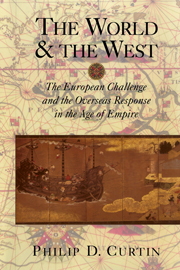Part Two - Culture Change and Imperial Rule
Published online by Cambridge University Press: 05 June 2012
Summary
Historians once characterized the development of European empires with a process model based on one-word names for a series of stages: voyage, factory, fort, empire. Two additional stages, decolonization and modernization, would have to be added to take account of the past half-century. The reality behind these one-word descriptions began with the European ability to sail anywhere in the world, to establish a place for their factors to trade, to fortify these shore establishment, and finally to see them turn into territorial empires. When the stage of empire was reached, the model became more complex. The overseas territory included a government administration with Europeans on top. Many local people had to be drawn into government administration. Some local social groups became richer and more powerful, whereas others became poorer and weaker.
Among the leading social groups demanding further change was an elite class conscious of Western material achievements. Its members became the modernizers who wanted some aspect of the material promise demonstrated in the industrializing world – for themselves, for their country, or both. Many came to want the high per capita incomes they saw in the West. They sought a variety of different means to that end – capitalist or socialist of various kinds. The promised goals could be very different, though they almost always included due respect for aspects of the local culture, which they rarely wanted to discard altogether.
- Type
- Chapter
- Information
- The World and the WestThe European Challenge and the Overseas Response in the Age of Empire, pp. 53 - 56Publisher: Cambridge University PressPrint publication year: 2000



